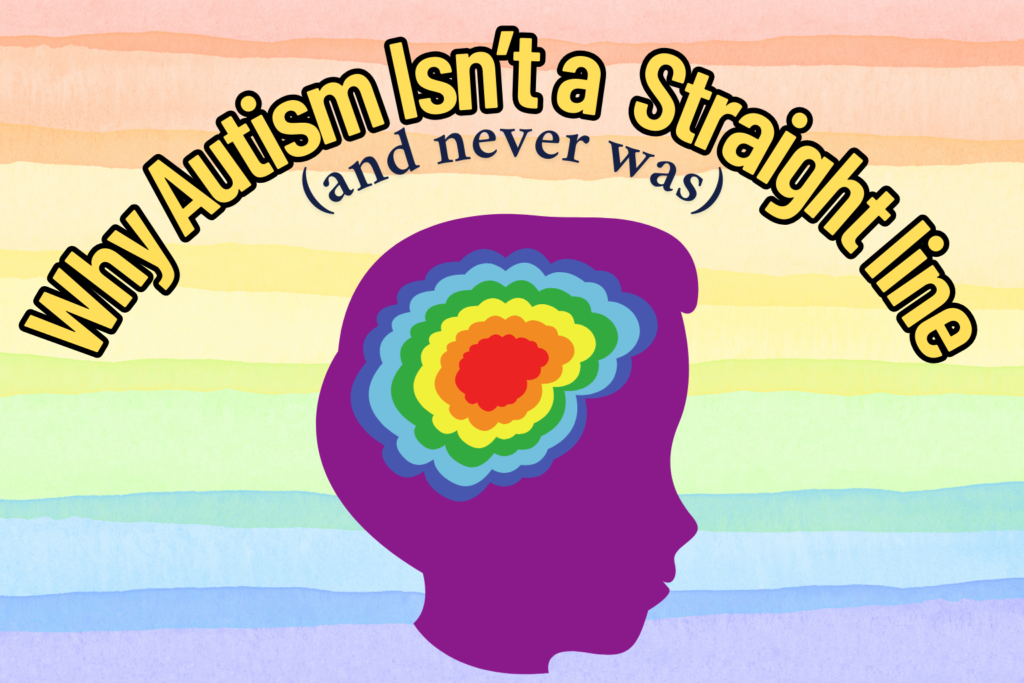
Why Autism isn't a Straight Line (and never was)
Let’s get one thing clear right off the bat: autism isn’t a ladder, a hierarchy, or a competition. It’s a spectrum — wild, wonderful, and not at all linear. Yet somehow, we still hear labels like “high functioning,” “low functioning,” or “Level 1” thrown around like they tell the whole story.
Spoiler: they don’t.
Where Did These Labels Come From, Anyway?
Somewhere along the way, someone decided it was helpful to sort autistic people into neat little boxes. It may have started with good intentions (or at least paperwork), but it quickly turned into a problem.
In the U.S., the DSM-5 (that’s the Diagnostic and Statistical Manual of Mental Disorders — try saying that before coffee) introduced Levels 1–3 in 2013:
- Level 1: Requiring support
- Level 2: Requiring substantial support
- Level 3: Requiring very substantial support
While technically meant to describe support needs, these levels have often been misinterpreted as a hierarchy — like Level 1 means “barely autistic” and Level 3 means “completely incapable.” Neither is true.
In the UK and other countries, you’ll also hear older terms like “Asperger’s”, “classic autism,” and the ever-popular (but deeply flawed) “high/low functioning.” These were never officially part of the DSM, but they slipped into the public conversation like bad advice in a parenting forum.
Why These Labels Just Don’t Work
Let’s be honest — no one fits neatly into a box, especially not kids. Here’s why these labels fall flat:
- They oversimplify. You can’t sum up a child’s entire experience in two words.
- They ignore variability. A child might mask at school (“high functioning!”) and melt down at home (“low functioning?”). Both are real. Both matter.
- They stigmatise. “Low functioning” can rob someone of autonomy. “High functioning” can strip away support. No one wins.
- They shift. A child’s support needs change. Yesterday’s “high functioning” might be tomorrow’s “overwhelmed and needs a hug.”
The Spectrum Isn’t a Line — It’s a Kaleidoscope
We need to stop picturing autism as a straight line from “less” to “more.” It’s more like a colour wheel — or a soundboard with dozens of sliders: sensory needs, communication style, motor skills, anxiety levels, social preferences… and so on.
Some autistic children are non-speaking and deeply attuned to visual language. Some are chatterboxes with big emotions and sensory sensitivities. Some are somewhere in-between. Some need help with transitions. Others need noise-cancelling headphones, a predictable routine, or just a bit more time.
And some need all of the above — depending on the day. Every autistic person is different because every autistic person is a person!
So What Should We Say?
Let’s ditch the labels and talk about what actually matters:
- What kind of support helps them feel safe?
- How do they communicate best?
- What lights them up — and what shuts them down?
- Where do they need scaffolding, and where do they shine?
Let’s speak in terms that honour individuality, not outdated categories. Describe the person, not the label.
Advocacy Starts with Language
If we want the world to embrace neurodivergent kids for who they are, we have to start by dropping language that boxes them in. Labels might feel tidy, but they often leave out the most important parts: the nuance, the context, the person.
Autism isn’t something to be ranked. It’s something to be understood. And every child deserves that level of care.
Like this post? Click below to share!
Read More...
What If It’s Not Defiance? Living with and Loving a PDA Child
What If It’s Not Defiance? Living with and Loving a PDA Child Parenting Outside the Lines means throwing away the rulebook—and sometimes rewriting it from
Beyond the Labels: Why Autism Isn’t a Straight Line (and Never Was)
Why Autism isn’t a Straight Line (and never was) Let’s get one thing clear right off the bat: autism isn’t a ladder, a hierarchy, or
Our Recommended Fidget Toys and Weighted Blankets
Our Recommended Fidget Toys and Weighted Blankets (Because sometimes, a little squeeze or a cozy hug makes all the difference.) If your household is anything
Our Must-Have Sensory-Friendly Clothing
Our Must-Have Sensory-Friendly Clothing (Because seams shouldn’t start screams, and socks shouldn’t ruin mornings.) Let’s be real: getting dressed shouldn’t feel like battle prep. But for sensory-sensitive
The Best Noise Cancelling Headphones
The Best Noise Cancelling Headphones (a.k.a. sanity savers) If I had a pound for every time a hand has flown to cover ears in this
Our Favourite Visual Schedules and Communication Boards
Our Favourite Visual Schedules and Communication Boards A round-up from one chaos-loving, neurodiversity-celebrating household to yours. If your mornings ever resemble a scene from a
